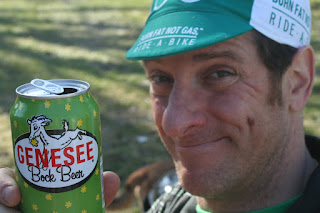When you are heading out for a ride always bring water with you. For example an average ride of 45 min or more your going to want to bring at least one or two bottles of water. Certainly with the many hydration options out there you could take more.
When is a good time to drink? Follow this rule of thumb..."drink often drink always" In fact in most cases by the time that you are "thirsty" you body actually needs a fair amount of water replenishment.
Signs of Dehydration:
- Increased thirst.
- Dry mouth and swollen tongue.
- Weakness.
- Dizziness.
- Palpitations (feeling that the heart is jumping or pounding)
- Confusion.
- Sluggishness fainting.
- Fainting.
Cold weather hydration:
When exercising in colder temps you certainly can become dehydrated. Yes believe it or not your body will lose a fair amount of water due to perspiration. The critical point is that because you may not necessarily feel "hot or sweaty" your body is working quite a bit harder than you realize. In cold weather, the body’s thirst response is diminished (by up to 40 percent even when dehydrated) This happens because our blood vessels constrict when we’re cold to prevent blood from flowing freely to the extremities. This enables the body to conserve heat by drawing more blood to its core.
Hydration tips:
- Use insulated water bottles (They have thermal liners which will prolong water from freezing)
- Place water into your containers as warm as you can (This will also prolong freezing)
- Use a back pack hydration system with an insulated bladder and drinking hose.
Each of the above tips are a few different suggestions that can help you with proper hydration. One key thing to keep in mind that the colder the temps and the more extreme the conditions water will eventually freeze regardless of your efforts. So keeping that in mind you may want to shorten the duration of your outdoor activity.
Warm weather hydration:
In warmer conditions hydration is even more critical. Because of the fact that it is warmer yes you will be sweating. In some cases if you are riding and there is a breeze etc you might not even be able to tell. So what to you do to stay hydrated? Again follow the rule of thumb, "Drink often, drink always. Make sure to NOT run out of water if you do make sure to stop an replenish asap!
Hydration tips:
- To keep water cold longer try putting water bottles (not filled to the top) in freezer
- Insulated bottles actually can keep water cooler on rides
- Hydration back pack / waist pack allow for easy hauling of extra water
- Try using an electrolyte hydration tablets (Nuuns / Camel Bak Elixer etc)
- Mix energy drinks in your water
We hope these tips and suggestions help, in the mean time, happy trails & don't forget to take time to stop and enjoy the ride !!! Any other question, comments, ideas or suggestions please feel free to drop us a line: info@growlerbikes we would love to hear from you !!!



